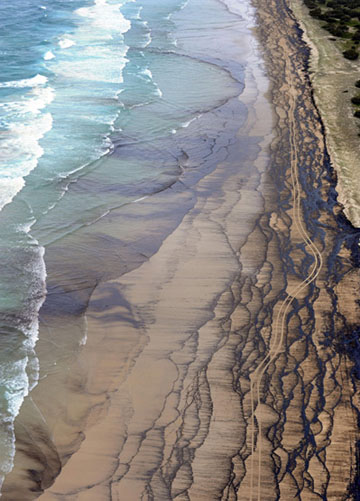Wildlife workers rescued turtle eggs and captured a few oil-coated pelicans off Australia's east coast Thursday while state officials assessed the extent of an oil spill from a cargo ship that was damaged in stormy seas.
 |
|
Photo taken on March 12, 2009 shows the beach polluted by an oil spill from a cargo ship that was damaged in stormy seas off Australia's east coast in Queensland. [Xinhua] |
The Pacific Adventurer's fuel stores were punctured when 31 containers of ammonium nitrate fertilizer slipped off the ship early Wednesday as the ship rocked in Australia's rough eastern waters, where a cyclone had stormed for the past week.
The spill of up to 34 US tons (30 metric tons) of oil created a slick spanning six miles (10 kilometers), and some of the oil had begun to wash up on beaches in Queensland state, leaving a black, sticky mess as the tide receded.
At Marcoola Beach, lifeguard official David McLean said oil globules stretched for about 1,000 yards (one kilometer) along the beach, which was closed due to the spill.
"As you walk along it sticks to the bottom of your shoe like glue," he said.
About 100 turtle eggs were collected from the beach by wildlife rescuers.
Five oil-coated pelicans flew in and joined a daily feeding session at Tangalooma Resort on Moreton Island. Workers managed to catch three of them and the Environmental Protection Agency planned to evacuate them for chemical cleaning treatment, Trevor Hassard, from the resort's Dolphin Education Centre, told the Brisbane Times newspaper.
"It just makes you want to cry," Hassard was quoted as saying. "This stuff is so hard to remove. If an animal like a bird gets oil on it, it basically dies. There's nothing we can do."
He said the oil would obstruct the insulating effects of the birds' feathers, and that they could be poisoned when they try to clean themselves.
Maritime Safety Queensland said it would take more than a week to clean up the spill.
An inquiry is being conducted into how the ship lost the containers, which held 694 US tons (620 metric tons) of ammonium nitrate, a fertilizer that can be used to make explosives. The containers have not been found.
 |
|
Photo taken on March 12, 2009 shows the beach polluted by an oil spill from a cargo ship that was damaged in stormy seas off Australia's east coast in Queensland. [Xinhua] |
State officials inspected the coast by air Thursday, and about 50 people checked for oil pollution on land and cleaned oil from soiled beaches on the east and northern shores of Moreton Island and Marcoola Beach.
Mike Short of the Environmental Protection Agency said the fertilizer in the lost containers would be diluted enough to avoid major problems. Ammonium nitrate can be explosive when exposed to heat or chlorine.
"The oil is our greatest concern, both to the environment and wildlife," Short said. "Spills and wildlife don't mix."
Marine expert Mike Kingsford, from James Cook University in Queensland, said the spill was small by global standards but that the oil would sit in the sand for some time before it turned to tar and became benign. He said the toxic effects would show within a few days, when plants, crustaceans and birds would probably die.
(Xinhua News Agency via agencies March 13, 2009)